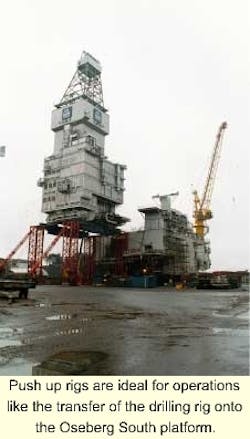Push-up technique ensures steady control during Spar assembly
Push up rigs are ideal for operations like the transfer of the drilling rig onto the Oseberg South platform.
The restart of the Spar production line at Aker Maritime's Mantyluoto yard at Pori in Finland has had a positive knock-on effect on the Swedish company, Rigging Management Systems (RMS), since it is contracted to undertake all the heavy lifts necessary in the yard to build these unique structures. Work began several months ago on the 30,000-ton Nansen platform for Kerr McGee and Boomvang (also Kerr-McGee). A third Spar, for Vastar's Horn Mountain Field, is set to follow.
Individual prefabricated sections of the Spars, commonly weighing 1,100 tons, are lifted into place using a push-up rig, designed, supplied and operated by RMS. The rig comprises four steel masts, which are guyed to the ground for stability, supporting two lifting beams. Hydraulic jacks at the base of each mast progressively raise the beams carrying the spar sections 20 meters into the air to be mated with the evolving structure. The lifts are well within the limit of the rig at the Mantyluoto yard, which is 2,400 tons. Aker's choice of a push-up rig rather than cranes for these lifts was based on two main features:
- Good control: Heavy loads can be lifted to considerable heights very safely and moved laterally in various directions with millimeter precision.
- Ability to operate reliably during Finnish winter: Temperatures in the region can fall to -25
Another factor favoring use of Rigging Management Systems' push-up rig for this work is that there is a series of very similar lifts involved. Jan-Erik Andersson, the company's managing director, concedes that one of the issues he normally has to address when selling the push-up lifting concept is that, unlike crane operations, formal certification is needed for each individual lift carried out. The repetitive nature of the work at Pori means the procedure has to be executed only once.
Stena Don/Oseberg
Andersson points out, however, that certification is rarely an issue when crucial and difficult individual lifts need to be carried out that require a high degree of planning and engineering. Module lifts onto platforms or drilling rigs are a good example. Last year RMS, with its Norwegian partner, TransRig, was responsible for lifting the 2,000-ton drilling module for Norsk Hydro's Oseberg South platform and mating it to the mud module at Aker's Stord yard in Norway. The 85-meter tall module was lifted 22 meters from the ground, and then skidded 40 meters over and onto the mud module, the entire operation being completed in about 10 hours.
The company is contracted for a similar operation at Kvaerner's Warnow yard in November. It will undertake the installation of the drilling module onto the Stena Don semisubmersible drilling rig. The rig is due for delivery in the first quarter of next year; its first contract is with Statoil for drilling in the Norwegian sector of the North Sea.
For more information contact Jan-Erik Andersson, Rigging Management Systems. Tel: +46 500 43 70 70, Fax: +46 500 43 67 40, E-mail: [email protected]






